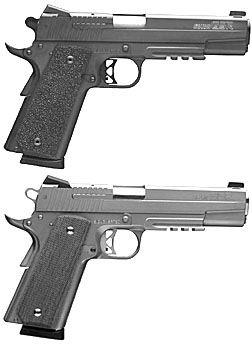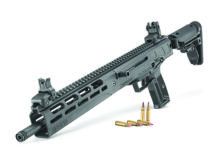CDC Advocates More Gun Studies
A federal review of the nations gun control laws – including mandatory waiting periods and bans on certain weapons – found no proof such measures reduce firearm violence. A task force of scientists appointed by the Centers for Disease Control and Prevention conducted the review.
The CDC said the report suggests more study is needed, not that gun laws dont work. But the agency said it has no plans to spend more money on firearms study – good news.
Gun-rights advocates have said that the CDC should limit itself to studying diseases, and some have complained in the past that the agency has used firearms-tracking data to push gun control. In fact, since 1996, the CDC has been prohibited from using funds to press for gun-control laws.
Since then, the task force reviewed 51 published studies about the effectiveness of eight types of gun-control laws. The laws included bans on specific firearms or ammunition, measures barring felons from buying guns, and mandatory waiting periods and firearm registration. In every case, a CDC task force found insufficient evidence to determine effectiveness.
Dr. Sue Binder, director of CDCs Center for Injury Prevention and Control, said, Its simply a review of the literature.
Firearms injuries, most of which are crime or suicide related, were the second-leading cause of injury deaths, killing 28,663 people in 2000, the most recent year for which data was available. Gun accidents claimed only about 775 lives that year.
About the only conclusion the task force could draw from the surveys was that mandatory waiting periods reduced gun suicides in people over 55. But even that reduction was not big enough to significantly affect gun suicides for the overall population.
The task force complained that many of the studies were inconsistent, too narrow, or poorly done.
Among the supposed problems:
• Studies on firearm bans and ammunition bans were inconsistent. Some showed the bans decreased violence; others found the bans actually increased violence. Many firearm bans grant exemptions to people who already owned the weapons, making it hard to tell how well a ban worked. Other evidence showed that firearms sales go up right before bans take effect.
• Studies on background checks were also inconsistent, with some showing decreased firearm injuries and others showing increased injuries. A major problem with those studies, the report said, was that denial of an application does not always stop applicants from acquiring firearms through other means.
• Only four studies examined the effectiveness of firearm registration on violent outcomes, and all of the findings were inconsistent.
• Too few studies have been done on child-access gun laws to gauge their effectiveness.
• Study periods often are too narrow to tell whether gun laws work. The task force noted that rates of violence may affect the passage of firearms laws, and firearms laws may then affect rates of violence.
———-

Exciting New Gun
SIGArms Inc. has begun production of its new Granite Series pistols. The newest SIGArms handgun is a 1911 design whose development began in April 2003.
The love child of SIG engineers and renowned gunsmith and world champion IPSC shooter Matt McLearn, the GSR (Granite Series Rail) will be built from stainless steel, with the frame and slide hand-fitted and hand-lapped.
The slide sports Novak rear sights and dovetailed front, Wilson Combat external extractor and top-of-the-line machined firing pin, firing pin stop and ejector. Other components include a 5-inch match-grade barrel, match-grade hammer/sear set, match-grade aluminum trigger, and Wolff springs.
The GSR also incorporates a beavertail grip safety with speed bump, an extended thumb safety, a firing pin safety and hammer intercept notch, and 20-lines-per inch grooves on the frontstrap and mainspring housing. The frame and slide are de-horned. A Picatinny rail integral to the dust cover accepts all tactical lighting systems designed for that system. The GSR is provided with two of Novaks eight-round magazines with integral bumper pads.
Our Take: Everybody seems to want to jump on the 1911 bandwagon (most recently S&W, whose gun was a disappointment in our tests). If good ingredients make a gun, then the Granite will challenge other makers. But the Valtro (page 27) will offer stiff competition, in our view.
———-
Ninth Circuit Reinstates Lawsuit
A recent decision by the Ninth U.S. Circuit Court of Appeals reinstates a lawsuit against Glock and RSR. The suit seeks to blame Glock and RSR for the criminal actions of white supremacist Buford Furrow, who wounded three children at a Jewish day care center and shot and killed a postal worker in California in 1999. Glock sold the pistol to a police department that later sold it to a licensed dealer who in turn sold it to a consumer who passed a NICS check, and RSR, a distributor, never owned or sold the pistol.
Our Take: This idiocy demonstrates why the Senate should pass the Protection of Lawful Commerce in Arms Act (S. 659) to stop junk lawsuits against the gun industry.
———-
.380 Auto Glocks
If youre interested in Glocks such as the Model 27 reviewed on page 21, you might already know that the company makes two pistols chambered in .380 Auto: The Glock 25 and Glock 28. Although they are not marketed in North America, except to law enforcement agencies, these pistols were developed for countries that forbid the civilian possession of a handgun chambered in a common military caliber.
The Glock 25 is the same size as the more powerful Glock models 19, 23 and 32. The Glock 28 is the same size and format as the Glock models 26, 27 and 33. The small pistols are blowback operated.
The 25 is 6.85 inches long and 5 inches tall. It is 1.18 inches wide with a sight radius of 6.02 inches. The barrel is 4.02 inches long. Capacity is 15, and the gun weighs 20.11 ounces. The 28 is 6.29 inches long and 4.17 inches tall, and is also 1.18 inches wide. It carries 10 rounds. A Glock 25 sells for about $875 Canadian.Our Take: The .380 enthusiast may find a rare used 25 or 28 if he keeps his eyes open. They would be fun guns to own.
———-

Product News
Through survey results and emails, readers have asked us to expand our new-product reporting. The following items are condensed from manufacturer-supplied information, and in our view, reflect interesting developments in the gun, ammunition, and firearms accessories markets:
• Ruger is chambering the .17 HMR in the Model 96 lever action. The Ruger Model 96/17 Lever Action Rifle has a 54-degree throw. The aluminum alloy receiver has a steel bolt with an 18.5-inch barrel. Cartridge capacity: Nine rounds. The gun measures 37.4 inches in length and weighs 5.25 pounds unloaded. Price: $375.
Our Take: The lever action offers firepower with the peppy .17 HMR that bolt guns weve tested dont. Looks like an easy way to spend a lot of money on ammo.…
• Savage will offer an inexpensive side-by-side. The Stevens Model 411 Upland Sporter will be made in 12 gauge, MSRP $395, and in 20 gauge and .410 bore for $432. The hammer-forged, chrome-lined barrels have 3-inch chambers designed to handle steel shot. The 12 gauge weighs 6.75 pounds, and the 20 gauge and .410 weigh 6.5 pounds. The 12 gauge has 28-inch barrels, and the others come with 26s.
Our Take: This inexpensive, lightweight SxS will challenge some of the imports on price. Could be a good bang-around gun for hard hunting.…
• Marlin will compete with Winchester in the .410 lever-action market with the new Model 410. Based on a .410 shotgun Marlin made more than 70 years ago, the Model 410 is built on the 1895 frame. It features a 22-inch barrel with a folding open rear sight, and a high-visibility green fiber-optic front sight. Capacity is four rounds.
Our Take: We found the similar Winchester 9410 to be a fun shooter. Unless the Marlin is found to be flawed in a future test, well probably like the Model 410 as well.




























